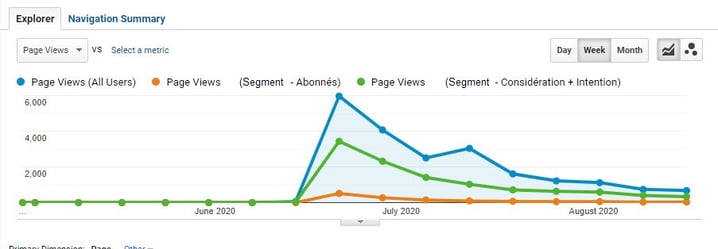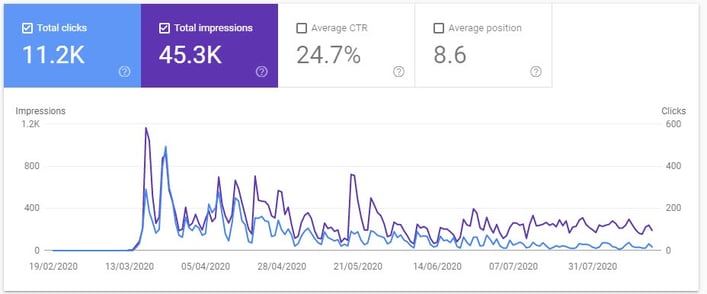Content Marketing Strategist
Taking your content strategy out of quarantine: where to begin?
Content Marketing Strategist
During the most critical part of COVID-19, many companies pressed pause on their content strategies, wondering when things would go back to normal.
One thing is certain, COVID-19 has caused major changes in consumer habits and imposed its fair share of limitations on brands. In the short term, many brands will need to adapt their digital media strategies to the new consumer reality to limit the impact of the drop in sales revenue as much as possible. In the medium and long term, they will need to reflect on how they think of and orchestrate their content strategies to better integrate them with our new reality – the “new normal” as some are calling it.
Now that marketing teams are relaunching their paused initiatives, one question looms: should we pick up our projects where we left off, or should we be making changes before going forward? If we need to make changes, then which? And above all, how? Regardless of your company’s situation, there are clues hiding in your data.
Looking to data for answers
Data is full of answers. The first thing to do if you are wondering if your customers are ready for your brand to go back to normal is to take the pulse of your customers. This will allow you to get a good idea of the degree to which COVID-19 is affecting their purchasing habits. With that in mind, there are two data sources you can look at: performance data for certain pages of your site and the volume of user searches connected to your website.
Your website data
By looking at how visits to your COVID-19-related pages have changed month-by-month, you’ll be able to get a good idea of your users’ overall feelings. For example, if you haven’t seen a significant drop in sessions between March and today, then your content is still being heavily consulted by users and you should probably wait a while before modifying or moving this content. Sensitivity to COVID-19 can also be partially determined based on industry, number of target groups and your business model.
In the example below, we looked at page view data for COVID-19 content for a service company and wanted to know if all segments were reacting the same way to content linked to COVID-19. We observed that the content wasn’t being heavily visited by existing customers (orange) but that potential customers (green) were using it more often. However, we can also see that the content appears to be less and less relevant to both segments as the months go by.

Because not every customer-base is affected in the same way, ask yourself the following questions when you analyze your data:
- Is the drop in traffic to COVID-19 content consistent across all pages?
- Are all vertical segments consulting the content in the same way?
There’s a good chance the answer to one of these questions is “no.” If that’s the case, you’ll have to make sure that your return to normal communications is done progressively, based on segment.
Analyzing user queries
The other option is to look at queries leading to your website. Are they COVID-19-related? How many are there? With a sufficient number of impressions and clicks, it’s easy to tell what type of content is still relevant to users. This also allows us to monitor new questions from users that would be worth responding to. This chart shows the six-month trajectory of queries containing COVID-19 for a particular brand. It demonstrates that users are searching less and less for COVID-19-related content.

It’s highly likely that the traffic generated by these queries will never drop down to zero. So we’ll have to find ways to adapt where we can.
Once our analyses are complete and we know more about our users’ attitudes about our COVID-19 content, then we can proceed to the gradual relaunch of our content strategies.
Gently (and partially) take your website out of quarantine
One pitfall to avoid when it comes to a return to normal, is the assumption that the situation will unfold in the same way for everyone. Rather than picking projects up where we left off before marketing activities halted, we need to go over them one by one, looking for optimization opportunities resulting from new consumer expectations. Start getting your content initiatives back to normal gradually, and continue watching how your users respond.
Segment your audiences and learn by testing
A company that offers multiple product types and targets multiple different customers should start relaunching their content strategy by targeting those customers less sensitive to COVID-19. Start by adapting the section of your website that targets that group, then segmenting your email database. You can also create social media audiences and adapt both your paid and organic publications. Segmenting your audiences is the best way to bring coherence and variety to your messages.
Once your audience has been segmented and your messaging adapted, conduct iterative tests on your initiatives, so that you are able to accurately measure their performance and learn from it. Setting up user tests is an excellent way to better understand your users’ reaction as a function of your value proposition. If your tests are conclusive and the response to your changes is positive, you can apply your changes to a larger share of the segment. If it isn’t conclusive, you can adapt your messages to adapt to users’ response and test it again in the next iteration.
What should you do with the emergency content you created for COVID-19?
Your initiatives linked to COVID-19 won’t become obsolete from one day to the next. One mistake to avoid would be to throw it all in the trash and never use it again. This content taught you more about your customer base than you may realize. It could easily be transformed into a long-term digital asset. For example, if you developed a chat section on your website, and the response was very positive, we would recommend keeping this initiative and adapting it to the “new normal.”
One thing is certain, the emergency work your marketing team did over the past few months isn’t lost. No one knows what the future holds, but whatever comes, adaptability will be your number one asset.









